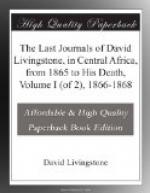I find that many Unyamwesi people are waiting here, on account of the great quantity of rainwater in front: it would be difficult, they say, to get canoes on Tanganyika, as the waves are now large.
24th January, 1868.—Two of Mohamad Bogharib’s people came from Casembe’s to trade here, and a body of Syde bin Habib’s people also from Garaganza, near Kaze, they report the flooded lands on this side of Lake Tanganyika as waist and chest deep. Bin Habib, being at Katanga, will not stir till the rains are over, and I fear we are storm-stayed till then too. The feeders of the Marungu are not fordable just now, and no canoes are to be had.
26th and 27th January, 1868.—I am ill with fever, as I always am when stationary.
28th January, 1868.—Better, and thankful to Him of the Greatest Name. We must remain; it is a dry spot, and favourable for ground-nuts. Hooping-cough here.
30th January, 1868.—The earth cooled by the rain last night sets all to transplanting dura or sorghum; they cut the leaves till only about eighteen inches of them are left, but it grows all the better for the change of place.
Mohamad believes that Tanganyika flows through Rusizi to Lohinde. (Chuambo.)
Seyd Seyd is said to have been the first Arab Sultan who traded, and Seyed Majid follows the example of his father, and has many Arab traders in his employment. He lately sent eight buffaloes to Mteza, king of Uganda, son of Sunna, by way of increasing his trade, but if is not likely that he will give up the lucrative trade in ivory and slaves.
Susi bought a hoe with a little gunpowder, then a cylinder of dura, three feet long by two feet in diameter, for the hoe: it is at least one hundredweight.
Stone underground houses are reported in Rua, but whether natural or artificial Mohamad could not say. If a present is made to the Rua chiefs they never obstruct passengers.
Chikosi, at whose village we passed a night, near Kalongosi, and Chiputa are both dead.
The Mofwe fills during the greater rains, and spreads over a large district; elephants then wander in its marshes, and are killed easily by people in canoes: this happens every year, and Mohamad Bogharib waits now for this ivory.
7th to 21st February, 1868.—On inquiring of men who lave seen the underground houses in Rua, I find that they are very extensive, ranging along mountain sides for twenty miles, and in one part a rivulet flows inside. In some cases the doorways are level with the country adjacent: in others, ladders are used to climb up to them; inside they are said to be very large, and not the work of men, but of God. The people have plenty of fowls, and they too obtain shelter in these Troglodyte habitations.
23rd February, 1868.—I was visited by an important chief called Chape, who said that he wanted to make friends with the English. He, Chisapi, Sama, Muabo, Karembwe, are of one tribe or family, the Oanza: he did not beg anything, and promised to send me a goat.




